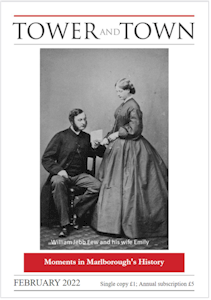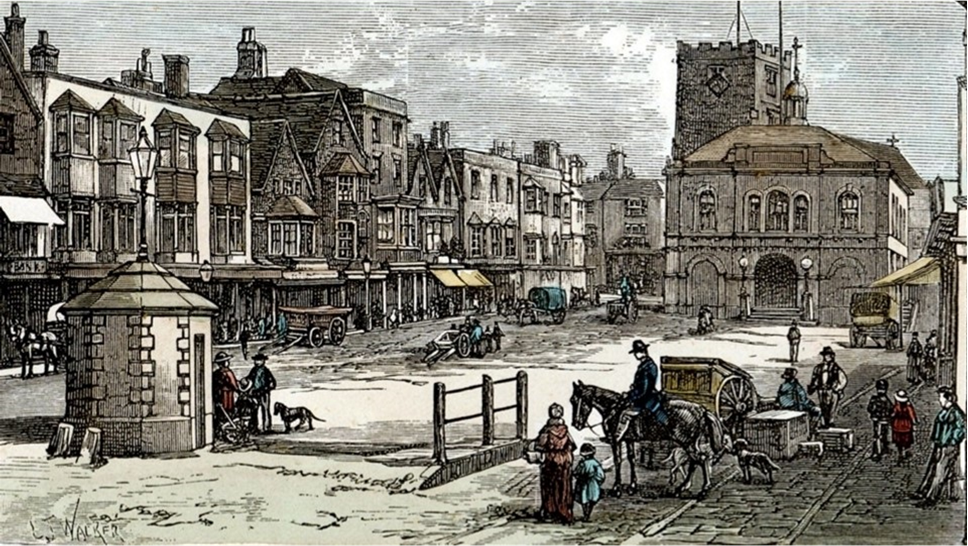

Tower and Town, February 2022 (view the full edition) (view the full edition)How Marlborough Became The Home Of Marlborough CollegeC House in Marlborough College began as a mansion during the reign of Queen Anne. On 26 August 1751, the Bath Journal reported it was leased as an inn 'for the better Accommodation of the Nobility...' The Castle Inn was named after the castle which once lay nearby. Improvements to the Bath Road increased traffic. In 1833, at the height of this golden age of coaching, William Carter obtained the lease.
The Industrial Revolution had transformed Britain. But few had the vote: demands for an extension of the franchise grew. Earl Grey's government attempted to placate the rising tide by introducing a reform bill. A general election followed when the bill was rejected. In Marlborough, many were unhappy that the vote was restricted to twelve members of the Town Corporation. Thomas Estcourt and William Bankes, Marlborough's MPs and candidates for re-election, were against reform. Some of the townspeople had petitioned Parliament. Thomas Merriman, a Corporation member, complained of "... gross, false, and slanderous libels on the Corporation." John Gardner, the mayor, presided over a stormy public meeting in the Town Hall. On 28 April 1831 the Devizes and Wilts Gazette reported: 'MARLBOROUGH. This town is in the highest state of excitement. The election takes place tomorrow; and it is not unlikely mischief will ensue.' On 5 May the Gazette reported: '... two effigies of Messrs Estcourt and Bankes were carried through the town accompanied with tin kettles and horns, and burnt at the crossroads.' Townspeople had expressed their feelings. A banner inscribed 'Enemies to Reform' was mounted on the wagon. The Reform Act was eventually passed on 4 June 1832. Chartists, who wanted more radical measures, caused serious disturbances in 1839 and 1842. Some in the Church of England felt that civilising influence was waning; there were not enough churches in the growing industrial towns; and there was a shortage of vicars. Education for clergymen's sons seemed to be the main problem. The grammar schools had become outmoded, bound as they were by their foundation charters, to teach mainly Latin and Greek. Public schools were thin on the ground. Some, like Rugby, had begun as grammar schools, and the largest, Eton, had fewer than 500 pupils. They were also expensive and out of the reach of most clergymen. A new kind of school, which taught a mixture of classical and modern subjects, and a 'collegiate' establishment where boys could board as well as learn seemed the answer. Large numbers would be needed to keep costs down. The idea began with the Rev. Charles Plater, who advocated a school primarily for the sons of clergy: others could come but they would have to pay more. The Church of England hierarchy embraced Plater's idea, backed by William Howley, Archbishop of Canterbury. On 1 July 1842, a meeting chaired by Howley was held to debate the proposed school for the Sons of Clergymen and Others. It was unanimously agreed it was, "desirable both for the assistance of clergymen in the education of their sons, and to meet the increasing wants of society." The Castle Inn in Marlborough was identified as the ideal site. The inn ceased trading on 5 January 1843, and was converted into dormitories: the stables and outbuildings into classrooms. In late August 1843, 203 boys aged between 8 and 16, arrived at the new school. In St Peter's church, Edward Denison, the Bishop of Salisbury and President of the School Council, preached 'a most eloquent and admirable sermon, explanatory of the great and important objects such an institution is calculated to attain, if based, as all education must be, to ensure success in its results, on the sure foundations of Christian religion.' The townspeople hosted a 'splendid banquet' at the Ailesbury Arms Hotel. The Mayor, Thomas Merriman, gave toasts to 'The Bishop and Clergy'; 'The President and Council'; 'Success to the New School'; and, in recognition of the efforts of Charles Brudenell-Bruce in encouraging the new school; 'The Marquis of Ailesbury'. Concerns that the new school might be considered an upstart to the Grammar School, founded by King Edward VI in 1550, were addressed by Thomas Merriman; who introduced a further toast: 'Success to the Royal Free Grammar School, with the health of the Rev. Mr Meyler, the master'. The School Council 'expressed their hopes that the tradesmen would co-operate with the masters in maintaining the discipline of the pupils; to which Mr Jonah Reeve, on behalf of himself and his brother townsmen, responded with very great propriety.' Jonah Reeve, High Street auctioneer and cabinet-maker, who was shortly to succeed Thomas Merriman as Mayor, represented the tradesmen. The Marlborough surgeon, John Gardner, had been in 1831 the unfortunate mayor who had witnessed the townspeople burning their MPs in effigy, as had Thomas Merriman. Gardner was the first medical officer to the new school, renamed Marlborough College in 1845. The vicar of St Peter's, Rev. Sir Erasmus Williams, was effectively the College chaplain until Edward Blore's chapel was completed in October 1848. The solicitor Robert Few was a founder of the College. His son, William Jebb Few, migrated there from the grammar school. Jebb was named after his mother, Louisa Jebb. Louisa's father, Richard Jebb, was the great grandfather of Eglantyne Jebb, who taught at St Peter's school (now the town library) and founded the Save the Children Fund in 1919. Eglantyne's uncle, James Gilmore, taught at the College and was housemaster at Littlefield from 1872 to his retirement in 1886. On 30 October 1851 Thomas Merriman married his second wife, Sarah; sister-in-law to Marlborough College's first master Matthew Wilkinson. In so many ways, Marlborough Town and Marlborough College share the same blood.  Marlborough Hight Street c.1865 Nick Baxter |